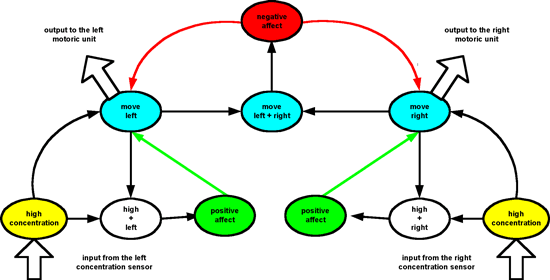
This issue in pdf Archive: Next issue: Next Special theme: |
|
|||
The Cogitoid: Towards a Computational Model of the Mindby Jirí Wiedermann and Martin Beran The cogitoid is an algorithmic model of the cognitive processes occurring in the mind of living organisms. A cogitoid presents a multimodal interactive learning algorithm that learns from experience. Thanks to its formal definition, the cogitoid allows formal reasoning about its ability to perform fundamental cognitive tasks. At the conceptual level, the cogitoid also offers a plausible framework for explaining higher mental functions. In the mid-nineties, a project in computational mind modelling was set up in the Institute of Computer Science at the Academy of Sciences of the Czech Republic. The aim of this project has been to develop a basis for an algorithmic theory of the mind by designing a formal model of the mind, deriving results about its cognitive abilities, investigating its explanatory potential regarding higher mental processes and, last but not least, experimentally verifying its viability in solving concrete cognitive tasks. Computationally, a cogitoid is viewed as a finite transducer that transforms a potentially infinite sequence of its sensory inputs into a similar sequence of actions. A cogitoid is realised as a network of concepts with associations among them. In the interaction of a cogitoid with the environment, both new concepts and associations are formed, strengthened or weakened. Emotions are also built into the model with the help of special predefined concepts, the activation of which modulates the sequence of activation of other concepts. A cogitoid works by iterating the cycle sense-compute-act. For such a model, theorems showing the ability to learn a sequence of stimuli (simple conditioning), learning by similarity, Pavlovian conditioning, and operant conditioning (learning by punishment and reward) have been proven. Proving theorems about more complex behaviour is complicated by the fact that in a cogitoid, many of the interactions that emerge among concepts and associations are difficult to capture formally. Therefore, the higher cognitive functions are not described by theorems, but rather by claims with supporting reasoning and verifying experiments. For cogitoids with sufficiently many concepts and rich interaction with a feedback from the environment, one can expect automatic formation of concept clusters in which concepts related to certain activities, contexts, or subjects are assembled. The clusters represent a basis for the mechanism of understanding and intention formation. By navigating among the respective clusters along the frequently strengthened associations, a behaviour based on the experience unfolds itself. In this way a number of high-level mental phenomena, such as imitative learning, self-control, the formation of the concept of self, language acquisition and generation, thinking, and a rudimentary form of consciousness, can be explained.
Recently there were several computational experiments performed with simple cogitoids. In the simplest case, a so-called 'computational bacterium' driven by a cogitoid has been designed, which was able to learn to move in one dimension towards a higher concentration of nutrients. A scheme of the respective cogitoid that eventually developed after interaction with a changing environment is depicted in the accompanying picture. This experiment has shown a need for two additional conditions to be defined for a cogitoid to operate successfully. The first condition deals with the question of a proper setting of positive and negative effects ('emotions') in order to strengthen desired and suppress unwanted behaviour. The second condition is concerned with the problem of the initial activity of a cogitoid that has not yet learned any behavioural patterns. In such cases, it appeared useful to equip the cogitoid with a body, which is driven by a very simple heuristic algorithm simulating 'reflexes'. The cogitoid then 'observes' the activities of its own body and after some time it takes over the control of its body. This has been verified in a more complex experiment where an originally blind agent was able to learn to use its additionally provided vision ability for avoiding collisions. A Masters thesis aiming at programming a cogitoid on a cluster of PCs has also been initiated. All these experiments have been performed at the Department of Computer Science in the Faculty of Mathematics and Physics at Charles University, Prague. Currently, experiments that are more complex are still under development. These will help in further understanding the abilities and limitations of cogitoids in realising non-trivial cognitive tasks. They will also help in finding better ways of designing a cogitoid as well as 'flaws' in its definition. The genetic algorithms for automatic cogitoid evolution and tuning are also under consideration. Finally, yet no less crucially, the plausible explanation of further details of the algorithmic mechanism behind the higher brain functions remains a focus of the current research. The research reported has been partially supported by GA CR grant No. 201/02/1456. Links:
Please contact: |
|||


